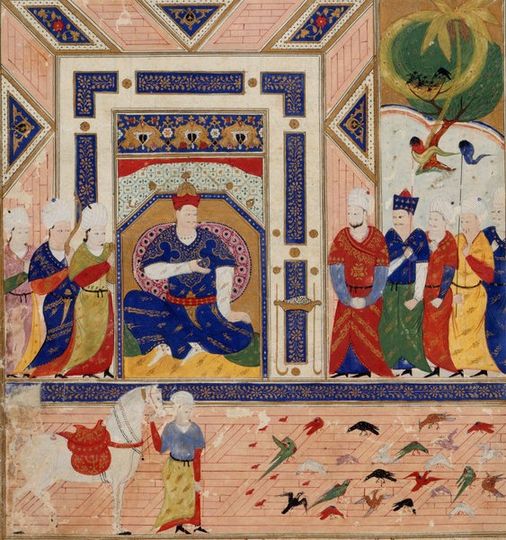



The period of the Later Ilyas Shahi dynasty (1435-1487 AD) was perhaps the greatest era of Bengal on the cultural side. It was this dynasty that patronised Bengali literature the most. And not just Bengali literature but also Persian literature aswell as various sciences such as the Ayurveda, astrolonomy & various arts. Surprisingly under the patronisation it's most powerful ruler Ruknuddin_Barbak_Shah (1459-1476 AD) Krittivasa composed the Bengali adaptation of Ramayana & Gunaraja_Khan composed the epic Sri Krishna Vijaya the most popular epic of the Sultanate period. It was also an era of social reforms such as Nulo Panchanan's movement, the Datta Khani movement, the Barendri movement of Udayanacharya_Bhaduri etc. So certainly a cultural high point of the Sultanate. The Later Ilyas Shahis certainly took the legacy of their ancestor Shamsuddin_Ilyas_Shah (1339-1358 AD). Atleast that's what's believed. Yet the historical sources really makes one doubt if they truly were the descendents of Ilyas Shah.
In most text-books it's usually written that the founder of the Later Ilyas Shahi dynasty #Nasiruddin_Mahmud_Shah (1435-1459 AD) was the great-grandson of Ilyas Shah. But what do the sources of the old actually say?
According to the Riyaz Al-Salatin which is from the 18th century but used earlier works, after the death of the last Kans Shahi ruler Shamsuddin_Ahmad_Shah 2 of his nobles named Sadi Khan & Nasir Khan struggled for power. After slaying Nasir Khan, Sadi wanted to become king himself. After 7 days (or half a day) of rule the nobles & secretaries of the court put him to death & raised one of the grandsons of Ilyas Shah to the throne. He would take the title Nasir Shah. The word used in Riyaz is از نبأر (Az Nabaer) which means amongst the grandsons.
Another source from the 18th century is Buchanan's account who had access to many lost manuscripts written in Bengal, "Ahmed Shah...reigned three years. He was destroyed by two of his nobles, Sadi Khan and Nasir Khan, the later of whom was made king, and erected many buildings at Gaur, to which he seems to have transferred the royal residence. He governed 27 years, and was succeeded by Sultan Barbuck Shah." Buchanan is stating that Ahmad Shah's noble Nasir Khan is Sultan Nasir Shah & mentions nothing about being Ilyas Shah's grandson.
Amongst the earliest sources we can find are from the 16th century. Namely the Tabaqat-i-Akbari & Gulshan-i-Ibrahimi. Both of these were written in distant lands beyond Bengal. One in North India & another in Deccan. They probably had relied on legends to an extent but are still important as our earliest available sources on the matter. They very much give the same account as the Riyaz & probably were the source behind the information in Riyaz. However these texts don't mention the word for grandson at all. The word in Tabaqat-i-Akbari is احفد which just means relative. Could be someone from direct family but also can be some in-law. Meanwhile Gulshan-i-Ibrahimi uses the word اولاد which just means descendent. Also unclear on the relation to İlyas Shah. Firishta also states Nasir was dedicated to farming before coming to the throne.
Now in those days it was not uncommon for ruling families to claim lineage from their in-laws. We know the Timurids did this. The last ruler of this dynasty Jalaluddin_Fateh_Shah (1481-1487 AD) styled himself as 'Sayyid' meaning a descendent of the Prophet Muhammad (Sa) through his daughter Fatima (Ra). Seeing no other ruler of this dynasty has claimed this lineage, he probably claimed it from his mother's side. Much like the Muzaffarids of Gujarat, rulers of this dynasty also used symbols of the Suryavamsa in their coins. Could it be that they were Sanatan who converted & married into the Ilyas Shahi family. However claimants to the Suryavamsa is also a bit weird in context of Bengal as Bengali ruling houses usually claimed lineage from the Chandravamsa & not Suryavamsa. There's also a receit of slave trade claiming a date equivalent to 1440 AD which mentions the king as 'Sulutan Mahamud Saha Gajan' (Bibliography of the Muslim Inscriptions of Bengal p.133) which is preserved at Dhaka University. Gajan has relations with Shiva the God of Destruction. However considering the Bengali language of that time, Gajan could also have been a Bengalification of Ghaznavi. We can't be certain.
And that's it. We've failed to determine the actual lineage of this dynasty. The thing is the dynasty itself cherished multiple lineages those of Saka, Sayyid & native. And this is not something unusual for that time. However there is no doubt that this dynasty was culturally Bengali. Perhaps referring to this dynasty as Mahmudi Shahi dynasty instead is more scientific instead of using Later Ilyas Shahi would be more scientific. However since most people will have trouble understanding I will be referring to them as Mahmud Shahi aka Later Ilyas Shahi dynasty from hence forward.
Author: Ishtiak Ahmed